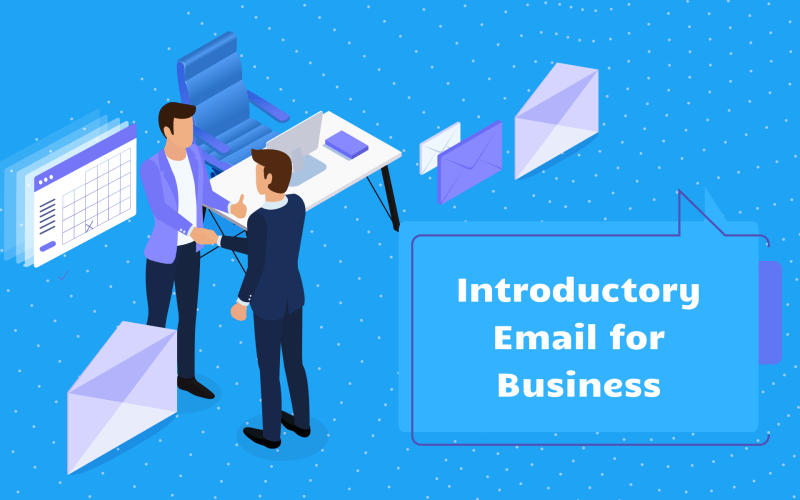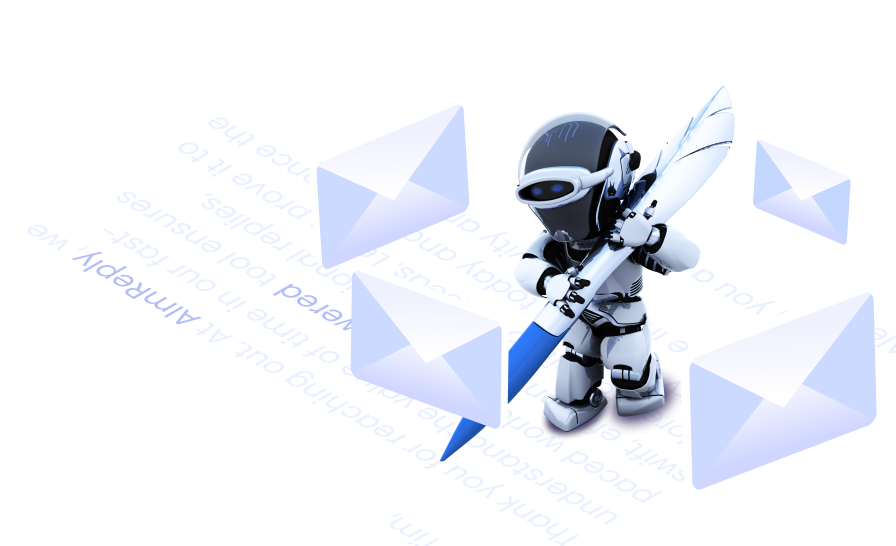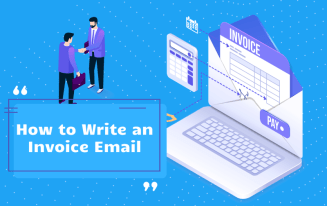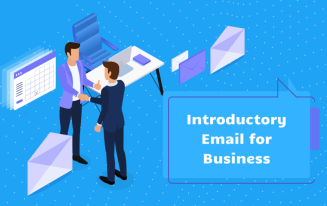How to Write an Introductory Email

In the world of business, you have to be able to sell yourself. This is where it can be helpful to know how to write an introductory email for business purposes. As with any form of professional communication via email, there’s always a bit of tact when it comes to the writing. Not only can this skill help increase sales, but it can also help influence long-term partnerships. This article will highlight how to write an introductory email and why AImReply can help you streamline the entire process.

Employ the full range of AI advantages with AImReply and express your thoughts faultlessly in every email.
Table of Content
- How to Write an Introductory Email
- A Guide on How to Write Intro Emails
- Introductory Subject Line Examples
- Templates for Introductory Emails
How to Write an Introductory Email
First impressions are everything, making the wording and format of introductory emails crucial from a business standpoint. Not only do these emails need to pitch a product or service, but it has to convince the reader to buy into what you’re selling.

Most people aren't eager to be sold too, which means this introduction shouldn’t sound like an ad. They should be personalized to each potential client while highlighting the most relevant information about the product or service. For a visual reference on this topic, keep reading below for a comprehensive checklist for crafting the perfect introductory email.
A Guide on How to Write Intro Emails
While every email should have your personal flair in the mix, there’s a general rulebook you can follow for every email. Going through your checklist with every email can ensure it ends up driving the best results possible.
It can be somewhat daunting as people tend to overthink every word they type out. Combining your objectives with well-known business intro email guidelines can be a recipe for success. The following steps are considered staples in how to write introductory emails.
- Subject line.This is the first point of contact your recipient will have with the email, and it's easily one of the most critical components. Not only should a subject line help to drive value, but it should also incentivize the recipient to read further. Using terminology such as partnership and collaboration can be more effective than basic marketing jargon. You want to try to build a connection with the individual rather than treat their inbox like ad space.
- Personalization.Most people can tell when an email is just a copy of a mass newsletter, and this in itself will feel pretty impersonal. Thankfully, there are many different ways to add a personal touch to an introductory email in business. From the subject line to the intro of the body text, calling the recipient by name is a great first step. However, you can take this one step further by tailoring a bit of the greeting as a whole to the situation. Segueing a unique identifier about the recipient into a relevant product or service is a good way to keep them reading.
- Details about yourself.While focusing on the potential client is important, you want to leave some decent highlights about your business and what you’re pushing. Starting with the basics, such as your name and the name of your business, make sure to talk about how you can bring value to the table. Once again, do your best to avoid too much sales jargon, as this can easily sway a reader’s opinion. Nevertheless, discussing who you are and what you do should take up three to five sentences max.
- Your motive.If there’s a direct motive behind your email, it can be helpful to add this point. This can act as a personal connection with the recipient and a potential call back to a previous interaction you may have had. Adding a motive to the text can also give the reader more of a reason to stick around and continue the conversation. Cold emails are still an important part of business, but most people don’t respond too well to them unless they’re crafted well. If there’s any motive you can reference, it’s best to put this near the top of the email to make that connection with the reader early on.
- Relevant partnerships and affiliations.Another angle that can be relevant to your motive is partnerships and affiliations, which can give your email a bit more credibility. If you’re able to highlight a connection that your recipient can relate to, then this automatically gives your voice a little more power. The recipient will be more inclined to hear you out if there’s a mutual connection somewhere. It’s important to note that this point isn’t a deal breaker, but it’s an added measure that can be helpful in getting a response.
Above all else, your personality and brand voice should shine through with every email. Write in your brand voice and describe what you bring to the table, as this will inevitably resonate with readers who could benefit from what you're selling. Always finish the email with a warm and inviting signature.

Introductory Subject Line Examples
With the subject line being the first point of contact, the wording in this space should require the most thought. It should effectively convey why you’re emailing them while driving enough subtle interest to get them to open the message. It’s understandable to overthink this part of the process, but based on the examples below, you’ll see it only requires a few words.
Here are a few subject line samples for an introductory email in business:
- Meet the Future of (Industry): (Your Company)
- A Formal Introduction For You
- Let’s Grow Together: Introducing (Your Company)
- Joining Forces With (Their Company)
- Let Me Take Your Business to the Next Level
- Stepping Into Success Together
- Introduction for Partnership
- Forming a Business Partnership
- Are You Ready to Connect?
- I’m Here to Help You
Some of these may not work depending on the circumstance, but they’re meant to strike interest in working together, regardless of the position or industry. The subject line is undoubtedly essential, but the body text has to be worth the read.

Templates for Introductory Emails
Depending on who you’re emailing, the tone and direction of your message are likely to shift a bit. Whether you're emailing an executive directly, an organization, or a potential client, crafting each email to the audience in question is important.
The samples below offer decent guidance on the direction you should take depending on the audience. As always, make sure to use these as inspiration and customize their direction to fit your writing style and brand voice.
1. Introductory emails to executives
Sometimes, the best way to get a hold of an organization is to contact the executives directly. This isn't always the best approach, but if you find the head of the department you're looking for, it doesn't hurt to try. Consider taking points from the following template when emailing an introduction to a business executive.
Subject: (Your Name) - (Company Name) - Introduction
Dear (Name of Executive),
My name is (Your Name), and I’m reaching out to introduce myself and connect with organizations in your industry. I have been a (field of expertise) for (x amount of years), and I feel this skill set would add quite a bit of value to your core initiatives.
The services I provide in this realm are comprehensive and aim to save you time while increasing brand awareness and ROI. I’d like to discuss the possibility of a potential partnership to see if I would be a good fit for your business needs.
With kind regards,
(Your Name)
The message is to the point while remaining friendly and open for further conversation. In this particular email, you’re taking a more personal stance with your writing. It highlights the service while speaking from an individual point of view.

2. Brand introductions
It isn’t uncommon to send introduction emails from a brand tone of voice, as this is a great way to build awareness and showcase a brand image. This also shows dedication to your product or service, and some potential clients may be more open to collaboration. Taking this professional stance can be helpful with business interactions, especially when it comes to first impressions.
Subject: Potential Collaboration With (Their Company Name)
Hello (Recipient Name),
I hope your week is going well! My name is (Your Name), and I’m the (job title) at (Your Company). I’m reaching out today as I love what you guys do, and I feel that a partnership between our brands could be pretty beneficial.
Although we work in separate industries, I’m sure you’re well aware they coincide with each other in more ways than one. After spending some time on your website, I have been brainstorming a few ideas I’d love to share with you.
If you’re open to it, I’d love to schedule a call sometime to discuss how our brands could collaborate in the near future. Let me know what you think, and I hope to hear from you soon!
All the best,
(Your Name)
It’s important to keep emails concise yet descriptive, which can be relatively challenging for many people. You want to include the most important points while keeping the email easily readable from top to bottom. From a brand perspective, it’s best to speak with a “we” perspective to show unity.
This is why learning how to write an email introducing two parties can also be advantageous. Most professional relationships are collaborative efforts between two or more organizations. Speaking with a team-focused voice can help to develop more positive relationships with recipients.

3. Introducing Yourself to Recruiters
Whether for brand collaborations, freelance work, or full-time hires, recruiters can be a great way to connect with an organization. They can help you land a new job or direct your portfolio and business information to higher-ups in the company.
Subject: Working With (Their Company Name)
Dear (Recipient Name),
My name is (Your Name), and I’m contacting you today on behalf of my organization, (Your Company Name). I’ve spent some time reviewing your company’s portfolio, and it became evident to me that our businesses have a lot in common.
Aside from that, my first-hand experience in our field would be highly valuable to your ongoing projects. I was curious if you'd be open to discussing a potential partnership, as I'd like to support your current initiatives through my curated services.
I know this conversation comes with a few nuances, so I’d be more than happy to set up a meeting sometime soon. Let me know your thoughts, and I hope to hear from you soon. Have a great week!
All the best,
(Your Name)
Keep in mind that these templates are a general standpoint with each circumstance. Expect each email to require a unique approach to be as effective as possible.
Being personable always works best, but driving the point home shouldn't take four to five paragraphs, either. Nevertheless, utilizing the various resources mentioned in this article will offer the support you need to send cold emails with confidence.

Establishing Credibility
Considering this is likely the initial interaction with the recipient, that means every word will leave a lasting first impression. That’s why people stress so much about these types of emails, as they’re seen as a make-or-break moment.
How you structure your introduction email will play into the overall credibility of your brand voice, products, and more. On top of describing who you are and what you do, these emails should also highlight one or two credentials that can help increase trust.
With the noisy nature of our digital age, people are used to getting a lot of spam in their emails. They’re already skeptical of contacts they don’t recognize, so you have to take a blended approach of personable yet professional in every message.
The Art of Cold Emailing
A necessary evil in the business world, cold emailing is a prominent form of digital communication in a professional setting. One primary reason is that it’s the most efficient and courteous method of contact.
In today’s world, people will avoid phone calls as they can seem a little too forward and rude regarding the other person’s time. Writing letters is merely too inefficient when trying to contact hundreds or thousands of contacts. So, cold emailing is the way to go, but it still comes with plenty of roadblocks of its own.
Although cold emailing is extremely common, it can be difficult to get the recipient to open such emails. This isn’t just because they decided to toss it in the trash, but spam filters, category filters, or outdated contact information can end up wasting time.
Fighting through spam and promotion folders can take some trial and error, as the wording and structure of your email are everything. It can be challenging to sell yourself without sounding like a salesman. Email service providers have numerous filters in place, and for good reason, but this can make cold outreach feel like a grind.
This is an accurate description, considering most people spend a few hours per day managing their emails. In regard to cold outreach, this is a numbers game. You’re going to end up emailing hundreds, if not thousands, of contacts, each deserving of a unique and personalized email. Doing this by hand will take hours to days, and it's a job that can be automated with ease.

How to Write Intro Emails With AImReply
There’s no argument that writing one email after another can feel extremely tasking as we need the recipients to read and react to our emails, so there is a need from our side to write them carefully, professionally, clearly, and straight to the point. Moreover, we all have important things to do in the day, and spending hours writing emails can end up feeling like a waste.
Thankfully, artificial intelligence is the perfect right-hand man for the job. AImReply is a service that’s built from OpenAI’s GPT technology, which means you can draft effective emails in seconds.
Some of AImReply’s most notable benefits include:
- You get an ideal, professional, mistakes-free well-written introductory email
- Automation offers unmatched time savings
- Each email the software writes is of a great quality and professionalism
- Enhance your writing proficiency with minimal effort
- Enjoy a user-friendly experience that comes with almost no learning curve
- Utilize inbox analysis tools to create detailed and accurate responses
- Take advantage of the free subscription to test the features for yourself

These bullet points speak for themselves, but the upside to using AImReply AI email generator doesn’t stop there. You can easily create numerous introductory emails for business use with the help of all the customization you need.
From tone of voice, context, writing style, and language, you can effectively connect with each recipient in a fraction of the time. Perfect for business professionals of all types, AImReply is leading the way when it comes to automating the email process.
Never write another email again
They say practice makes perfect, and although this is true, there's no need to be shackled to a manually tedious task that AI can handle with proficiency. Knowing how to write introductory emails is crucial, but the action of writing itself can be handed off to technology.
Consider giving AImReply a test run today by signing up for a free account and knocking out all your emails in seconds rather than hours.

March 25, 2024
- 10 min
- 141
Having to call in a sick day can be nerve-wracking as we want to convey the situation as clearly as possible. To avoid causing any hassle for colleagues when you’re sick, you’ll want to know how to write a sick day email for work.
March 18, 2024
- 8 min
- 126
If you want to get paid on time, you’ll want to learn how to write an invoice email for any professional situation. Although you’re owed payment for your work, being courteous and professional in your writing is important.
March 04, 2024
- 7 min
- 70
Knowing how to write an email subject line can come with several benefits, whether for personal or professional use. The nuances of subject lines can make or break communication in many circumstances. This article provides the insight and examples you need to craft attention-grabbing subject lines with every email.












